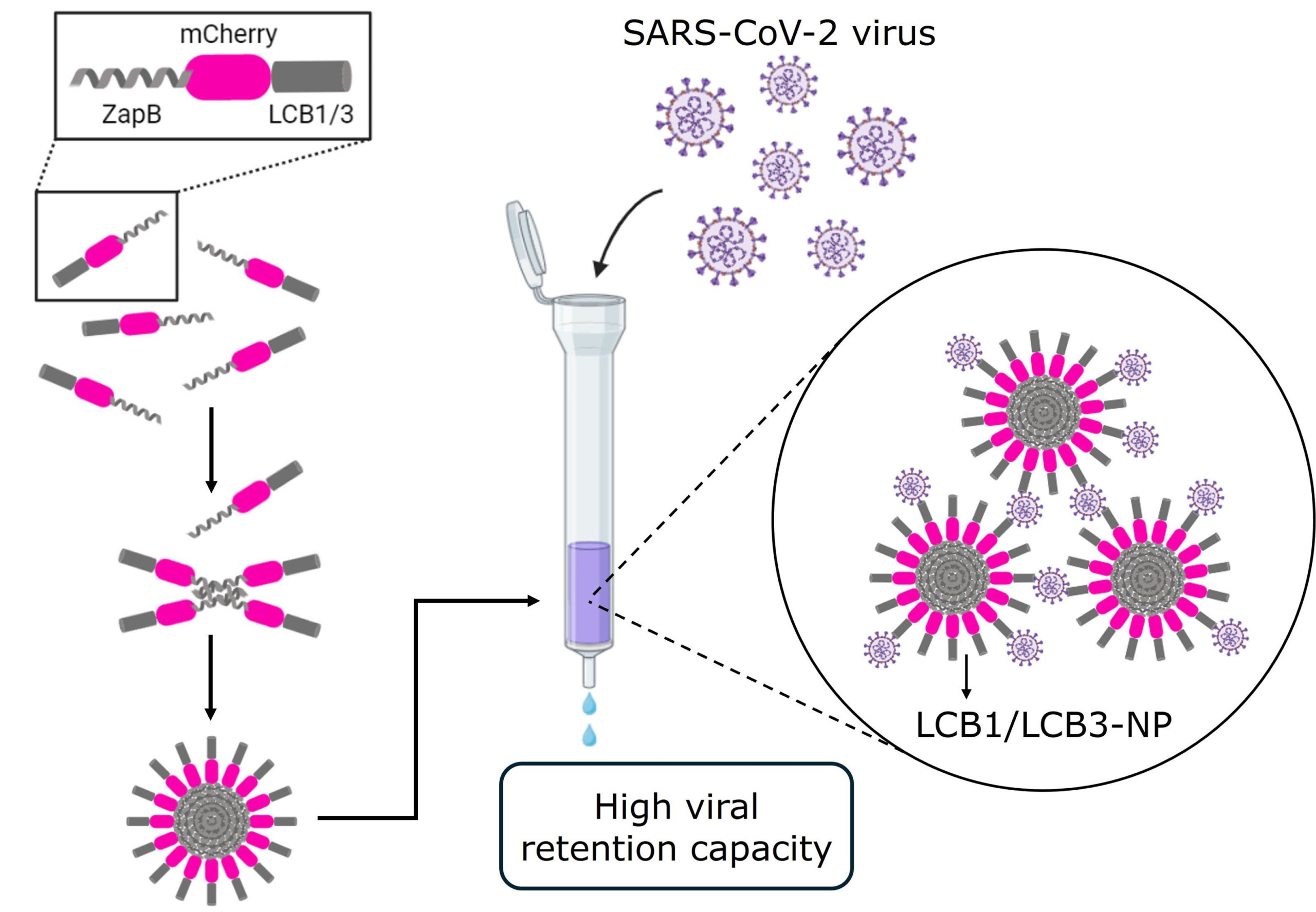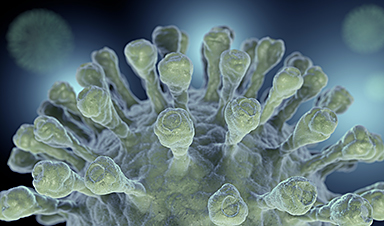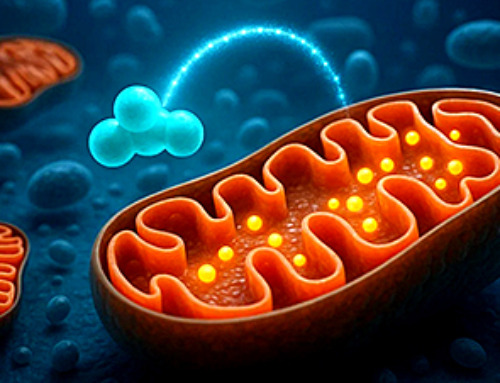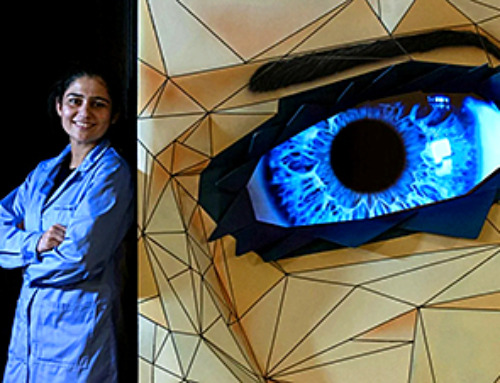| (Nanowerk News) Researchers from the IBB-UAB have developed a new class of nanostructures capable of trapping and neutralising large quantities of the SARS-CoV2 virus particles, both in liquid solutions and on the surface of materials. These novel nanoparticles could be used to manufacture antiviral materials such as wastewater and air filters, and could be exploited to develop new tests for the early detection of Covid-19. Moreover, the nanoparticles could be redesigned to target other pathogens. | |
| The study was led by researchers from the Institute for Biotechnology and Biomedicine of the Universitat Autònoma de Barcelona (IBB-UAB), who highlight the potential of the developed nanostructures for the manufacturing of new antiviral materials. | |
| The study was published in the journal Advanced Healthcare Materials (“Protein Nanoparticles for Targeted SARS-CoV-2 Trapping and Neutralization»”). | |
| The new nanoparticles, called LCB1-NPs and LCB3-NPs, are formed by repeats of three proteins, which are joined together thanks to the self-assembly properties of one of the three, called ZapB. In the genetic engineering strategy that was implemented, the researchers fused ZapB with the mCherry protein, which confers red fluorescence to the nanoparticles, and to this union they added the LCB1 and LCB3 proteins, which provide the ability to bind and neutralise the SARS-CoV-2 virus. Thus, by forming these nanostructures, it was possible to localise all these functions in a single nanoparticle. | |
 |
|
| Illustration of the formation of the new nanoparticles, LCB1-NPs and LCB3-NPs, designed by the IBB-UAB researchers. (Image: IBB-UAB) | |
| The researchers underscore the high affinity of the nanoparticles to bind to the viral spike protein that allows SARS-CoV2 internalization into cells. This process enables the nanoparticles to neutralise the infection in both liquid solutions and immobilised on a surface. This demonstrates the great versatility of this new antiviral nanomaterial, paving the way for its utilisation in a multitude of applications. | |
| “Each nanoparticle is composed of many LCB1 or LCB3 proteins, resulting in a high density of SARS-CoV-2 binding sites that allow each nanoparticle to bind to more than one virus. This greatly increases their potential as an antiviral material compared to other materials in which each nanostructure can only bind to one single particle of the virus,” explains IBB-UAB researcher Marc Fornt, first author of the study. | |
| The red fluorescence makes it easier to track and localize the nanoparticles with the naked eye, which makes them much easier to handle. | |
| An experiment using the nanoparticles to engineer a virus filter has allowed the researchers to demonstrate the ability of this new nanomaterial to trap and neutralise large quantities of SARS-CoV-2. Among its applications are the filtering of wastewater containing secretions from patients affected by Covid-19 to prevent them from reaching the water system, and the filtering of air in sensitive areas such as hospital wards. The nanoparticles could also be used in the manufacturing of new ultra-sensitive detection tests to diagnose the disease in the early stages of infection, when the viral load is still very low. | |
| “These new nanoparticles are also of great interest for the industrial production of antiviral materials due to the simplicity, speed and low cost involved in making them,” says IBB-UAB researcher and director of I3PT Salvador Ventura, who coordinated the study. | |
| The modular system through which the nanostructures were generated allows the protein that recognises and neutralises SARS-CoV-2 to be replaced by proteins that recognise other pathogens of interest. “This flexibility provides a solid framework for the generation of new materials to combat potential emerging infectious diseases effectively and rapidly, particularly if combined with recent advances in de novo protein design,” concludes Salvador Ventura. |
| Source: Universitat Autònoma de Barcelona (Note: Content may be edited for style and length) |
News
Differentiating cancerous and healthy cells through motion analysis
Researchers from Tokyo Metropolitan University have found that the motion of unlabeled cells can be used to tell whether they are cancerous or healthy. They observed malignant fibrosarcoma cells and [...]
This Tiny Cellular Gate Could Be the Key to Curing Cancer – And Regrowing Hair
After more than five decades of mystery, scientists have finally unveiled the detailed structure and function of a long-theorized molecular machine in our mitochondria — the mitochondrial pyruvate carrier. This microscopic gatekeeper controls how [...]
Unlocking Vision’s Secrets: Researchers Reveal 3D Structure of Key Eye Protein
Researchers have uncovered the 3D structure of RBP3, a key protein in vision, revealing how it transports retinoids and fatty acids and how its dysfunction may lead to retinal diseases. Proteins play a critical [...]
5 Key Facts About Nanoplastics and How They Affect the Human Body
Nanoplastics are typically defined as plastic particles smaller than 1000 nanometers. These particles are increasingly being detected in human tissues: they can bypass biological barriers, accumulate in organs, and may influence health in ways [...]
Measles Is Back: Doctors Warn of Dangerous Surge Across the U.S.
Parents are encouraged to contact their pediatrician if their child has been exposed to measles or is showing symptoms. Pediatric infectious disease experts are emphasizing the critical importance of measles vaccination, as the highly [...]
AI at the Speed of Light: How Silicon Photonics Are Reinventing Hardware
A cutting-edge AI acceleration platform powered by light rather than electricity could revolutionize how AI is trained and deployed. Using photonic integrated circuits made from advanced III-V semiconductors, researchers have developed a system that vastly [...]
A Grain of Brain, 523 Million Synapses, Most Complicated Neuroscience Experiment Ever Attempted
A team of over 150 scientists has achieved what once seemed impossible: a complete wiring and activity map of a tiny section of a mammalian brain. This feat, part of the MICrONS Project, rivals [...]
The Secret “Radar” Bacteria Use To Outsmart Their Enemies
A chemical radar allows bacteria to sense and eliminate predators. Investigating how microorganisms communicate deepens our understanding of the complex ecological interactions that shape our environment is an area of key focus for the [...]
Psychologists explore ethical issues associated with human-AI relationships
It's becoming increasingly commonplace for people to develop intimate, long-term relationships with artificial intelligence (AI) technologies. At their extreme, people have "married" their AI companions in non-legally binding ceremonies, and at least two people [...]
When You Lose Weight, Where Does It Actually Go?
Most health professionals lack a clear understanding of how body fat is lost, often subscribing to misconceptions like fat converting to energy or muscle. The truth is, fat is actually broken down into carbon [...]
How Everyday Plastics Quietly Turn Into DNA-Damaging Nanoparticles
The same unique structure that makes plastic so versatile also makes it susceptible to breaking down into harmful micro- and nanoscale particles. The world is saturated with trillions of microscopic and nanoscopic plastic particles, some smaller [...]
AI Outperforms Physicians in Real-World Urgent Care Decisions, Study Finds
The study, conducted at the virtual urgent care clinic Cedars-Sinai Connect in LA, compared recommendations given in about 500 visits of adult patients with relatively common symptoms – respiratory, urinary, eye, vaginal and dental. [...]
Challenging the Big Bang: A Multi-Singularity Origin for the Universe
In a study published in the journal Classical and Quantum Gravity, Dr. Richard Lieu, a physics professor at The University of Alabama in Huntsville (UAH), which is a part of The University of Alabama System, suggests that [...]
New drug restores vision by regenerating retinal nerves
Vision is one of the most crucial human senses, yet over 300 million people worldwide are at risk of vision loss due to various retinal diseases. While recent advancements in retinal disease treatments have [...]
Shingles vaccine cuts dementia risk by 20%, new study shows
A shingles shot may do more than prevent rash — it could help shield the aging brain from dementia, according to a landmark study using real-world data from the UK. A routine vaccine could [...]
AI Predicts Sudden Cardiac Arrest Days Before It Strikes
AI can now predict deadly heart arrhythmias up to two weeks in advance, potentially transforming cardiac care. Artificial intelligence could play a key role in preventing many cases of sudden cardiac death, according to [...]





















